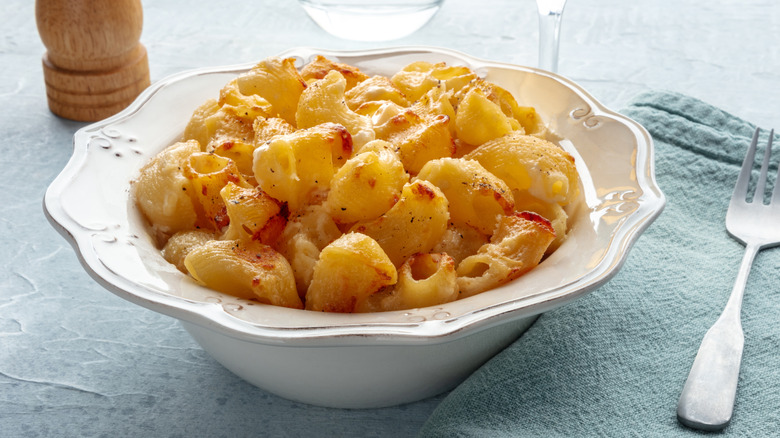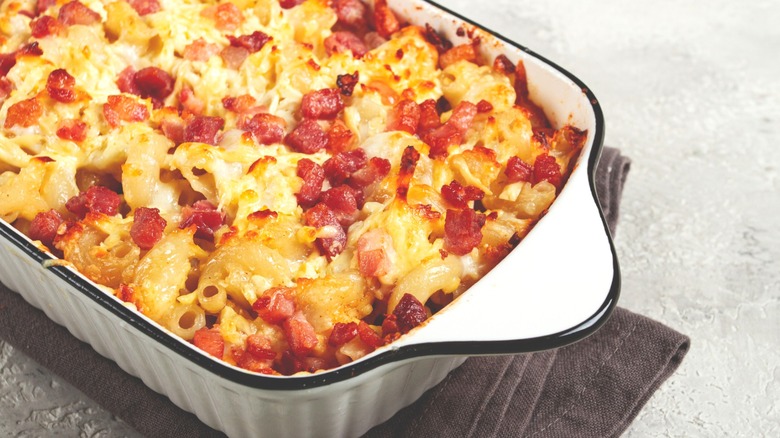If You're Not Baking Your Mac And Cheese, You're Seriously Missing Out
Boxed macaroni and cheese is typically prepared on the stovetop, and while it may be comforting, it's also rather monotextural (with the predominant texture being squishy). But there's so much more than Kraft mac and cheese, according to A.) My mom, and B.) River Robinson, senior sous chef at Sonoma County's Bricoleur Vineyards. As Robinson enthused in an interview with The Takeout, "A baked mac and cheese brings me so much joy ...The texture is the balance of a crunchy bite from the panko on top, to the soft creamy texture you get from making your own sauce."
Another advantage of baked mac and cheese is versatility. Robinson noted, "You can play around using different cheeses and spices to give your dish some extra love." (More on that in a minute.) He elaborated, "You get some control of the flavor profile when you make baked mac and cheese! And for the appeal, it is one dish that everyone just absolutely has to have when they see it at the table; you can't pass that up."
How to bake macaroni and cheese
If you've only ever made stovetop mac and cheese, rest assured that the baked kind isn't much more difficult. It's practically the same process, but with one extra step: the baking, of course. It begins with cooking and draining the pasta, although River Robinson advises stopping the cooking slightly before the pasta hits al dente since it'll continue to soften in the oven. He also rinses it afterwards, explaining: "I normally never, ever rinse my pasta but when I make baked mac and cheese, I do. This helps you to control the texture of your pasta, and it won't get mushy as it bakes. It also removes that extra starch that makes the pasta stay stuck to itself."
Once the pasta is drained and rinsed, Robinson tosses it with a little olive oil to minimize sticking, and starts the cheese sauce. "Making a mornay sauce is just perfect for baked mac and cheese," he told us. "Mornay is a béchamel, but adding cheese." (Béchamel is one of the five mother sauces of classic French cooking.) His preference is to use one hard cheese (e.g., parmesan) and one soft or semi-soft cheese (like Swiss or cheddar). He also cautioned, "Make sure you cook the flour taste out of your mornay sauce, or it will taste chalky."
Once the sauce is finished, Robinson mixes half of it with the cooked pasta, then puts the pasta in a baking pan and pours in the rest of the sauce. He generally makes macaroni and cheese the day before he cooks it, although he waits until right before baking to add any toppings.
Take your baked macaroni and cheese over the top
River Robinson is passionate about the pasta he uses, rhapsodizing, "I love, love, love using conchiglie (A.K.A., pasta shells). That shape just picks up all the sauce perfectly and, personally, brings back a lot of childhood memories of my godmother making her baked mac and cheese when I would go visit." And, along with a blend of different cheeses for the base of his sauce, he added, "Sometimes I mix in a touch of goat cheese for tang and extra creaminess."
Robinson also likes to mix and match his add-ins, noting, "One time I added Old Bay seasoning into my mornay and used a mix of gouda and pecorino cheese, then made a mix of green onion and panko topping, so bomb! All that was missing was some buttery lobster." Other ingredients he endorses include shredded chicken, sautéed mushrooms, and caramelized onions, while bacon and ham would be tasty, too. You can also change up the panko breadcrumbs to make a crunchy topping from potato chips, cracker crumbs, or crushed Cheetos. (After all, the Cheetos brand now includes boxed mac and cheese.) According to Robinson, "The flavor combination to a baked mac and cheese is just endless."


